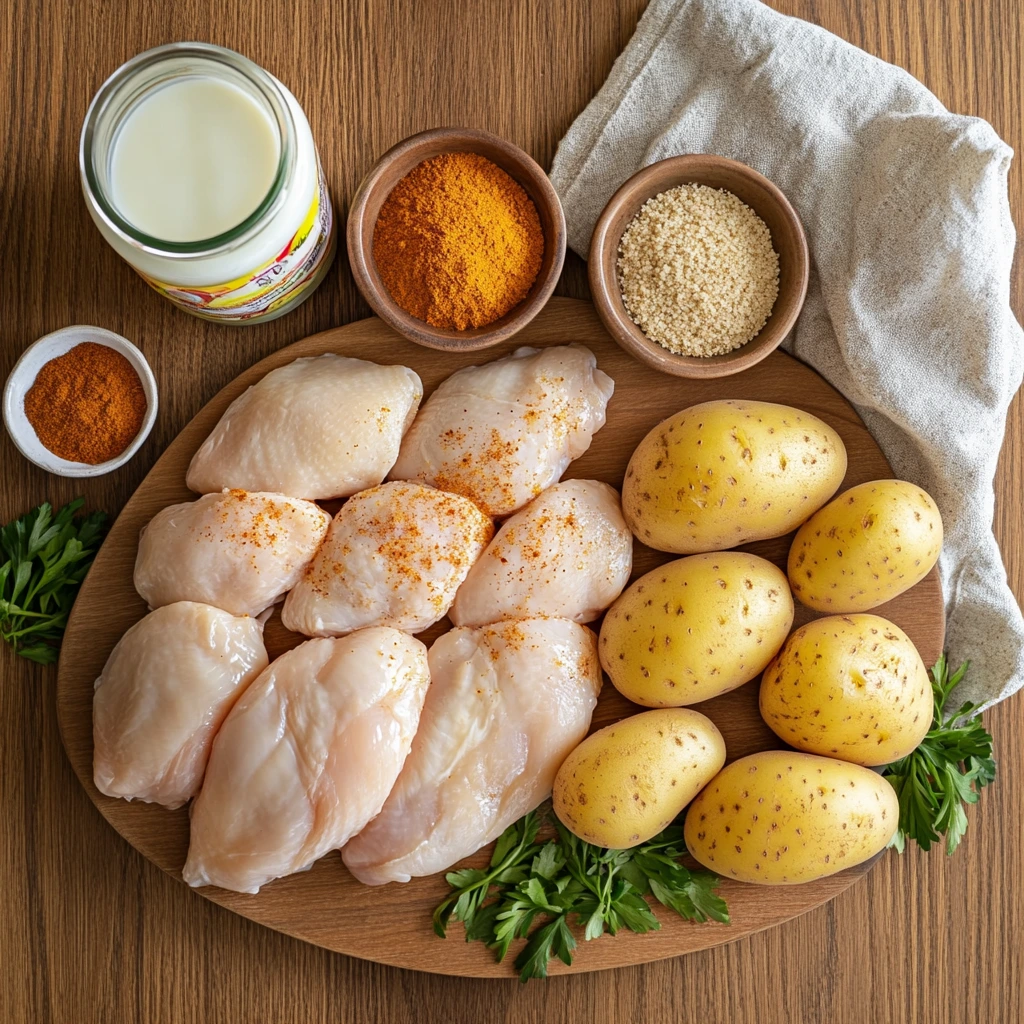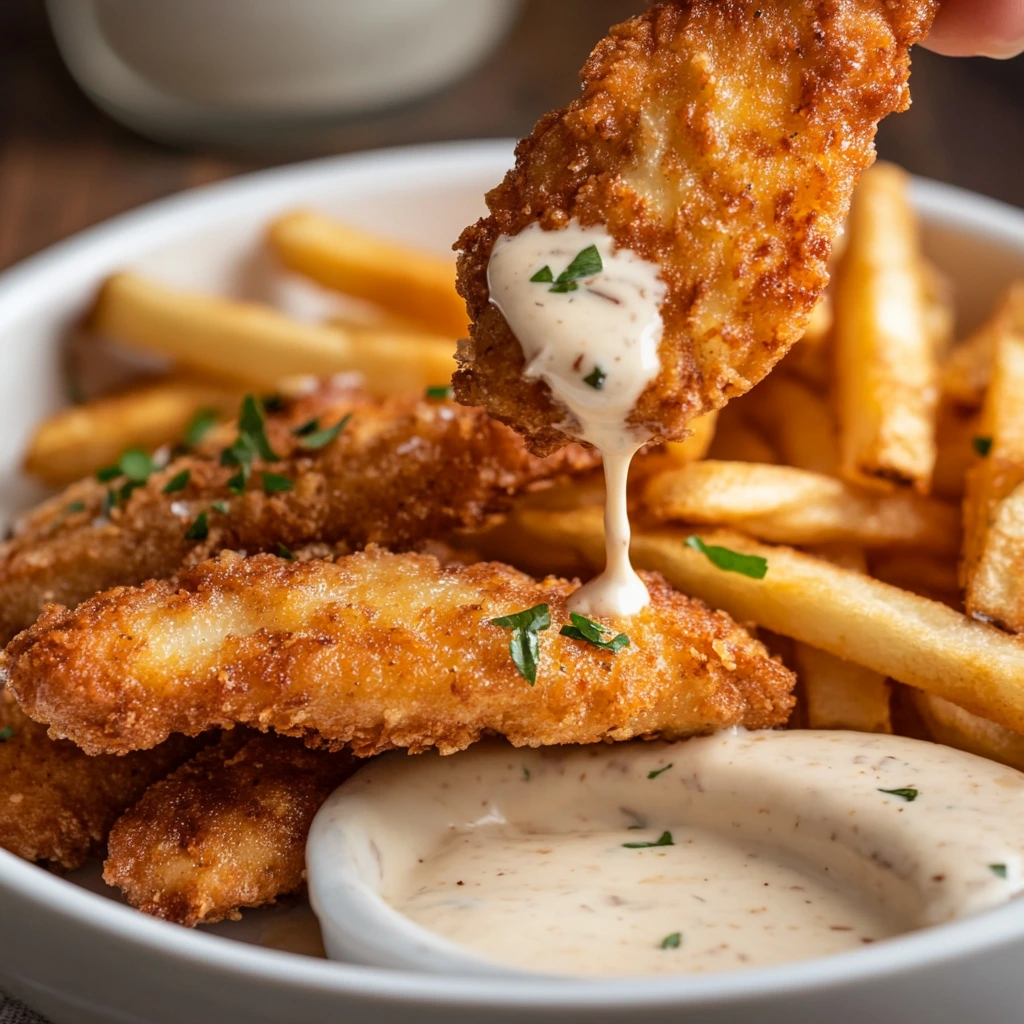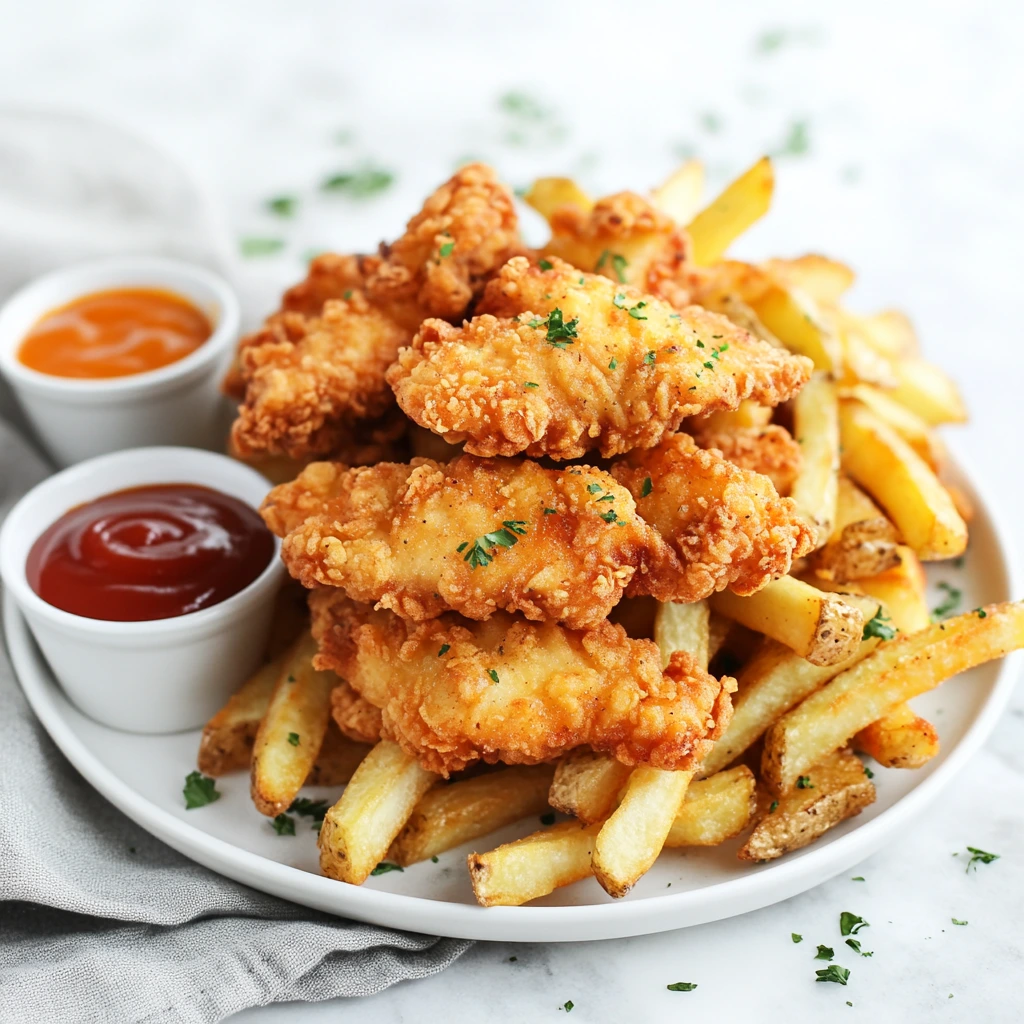There’s something universally appealing about chicken tenders and fries that transcends age, culture, and occasion. These crispy, golden delights have carved a permanent spot on menus and in our hearts, from casual diners to high-end eateries. With their crunchy exterior, tender and juicy interior, and the perfect pairing of salty, crisp fries, it’s no surprise that chicken tenders and fries have become a staple comfort food for many.
This article delves into the reasons behind their enduring popularity, examining their nostalgic charm, versatility, and the emotional connection they create. We’ll also explore how they manage to remain a favorite choice for food lovers of all ages, thanks to their ability to adapt to evolving tastes and culinary trends. Whether it’s for a quick snack, a hearty meal, or a midnight craving, chicken tenders and fries have an undeniable pull that keeps us coming back for more.
1. The History of Chicken Tenders and Fries
Origins of Chicken Tenders
Chicken tenders are believed to have started in the United States during the mid-1900s. These are strips of chicken, usually taken from the tenderloin, coated in breading and fried until crispy. While no one knows exactly who made them first, one popular story comes from the Puritan Backroom restaurant in New Hampshire, which claims to have served them as early as the 1970s.
Chicken tenders quickly became popular because they were easy to prepare, delicious, and could be enjoyed by everyone, from kids to adults. Over time, they found their way into fast-food menus and home kitchens, becoming a favorite for their crunchy texture and savory taste.
You can read more about their origin and evolution in this article: Who Invented Chicken Tenders and Fries?.”
Evolution of French Fries
French fries have a long history, starting in Europe hundreds of years ago. Belgium and France both claim to have invented fries, but it’s thought that Belgian villagers began frying potatoes in the 1600s when fishing wasn’t possible during the cold winters.
Fries became more popular worldwide in the 1900s. American soldiers returning from Europe after World War I brought the idea home, and fries started appearing in restaurants. With the growth of fast-food chains like McDonald’s, fries became a go-to side dish that people could enjoy with almost anything.
Combining the Two: A Perfect Pair
The combination of chicken tenders and fries became popular in the late 1900s, thanks to the rise of fast food. The mix of crispy fries and juicy chicken tenders was a winning match that people couldn’t resist.
This duo is easy to eat, satisfying, and perfect for any occasion. Today, chicken tenders and fries are not just a meal—they’re a comforting classic loved by people all over the world.
2. What Makes Chicken Tenders and Fries Irresistible?
Texture and Flavor Profile
One of the main reasons chicken tenders and fries are so loved is their perfect combination of textures and flavors. Chicken tenders have a crispy, golden coating that gives way to a juicy, tender interior, creating a satisfying bite every time. Fries complement this with their crunchy exterior and soft, fluffy center, making them an ideal pairing.
The flavors are just as appealing. The savory taste of chicken pairs perfectly with the salty, slightly sweet flavor of fries. This balance of crunchy and tender, savory and salty, creates an addictive eating experience that keeps people coming back for more.
Versatility in Dipping Sauces
Chicken tenders and fries are made even better by the endless variety of dipping sauces. From classic choices like ketchup, barbecue sauce, and ranch to more adventurous options like honey mustard, buffalo sauce, or sriracha mayo, there’s a sauce for every taste.
Dipping sauces allow people to customize their meal, adding new layers of flavor and fun to every bite. This versatility means that chicken tenders and fries can taste different every time, making them an exciting and never-boring choice for any meal or snack.
Comfort Food Appeal
Beyond taste and texture, chicken tenders and fries are the ultimate comfort food. They evoke feelings of happiness and nostalgia, reminding people of childhood meals, fun outings, or cozy nights at home. This emotional connection makes them more than just food—they’re a source of comfort and joy.
Psychologically, their simplicity and familiarity play a big role in their appeal. They’re easy to eat, easy to love, and bring instant satisfaction. Whether you’re stressed, celebrating, or just hungry, chicken tenders and fries have a way of making everything feel a little better.
3. Variations Across Different Cultures
American Southern-Style Tenders and Fries
- Marination and Seasoning: Southern-style tenders are marinated in buttermilk for tenderness and flavor. The coating is made from seasoned flour or spicy batter, often including paprika, garlic powder, and cayenne pepper.
- Frying Style: Deep-fried to achieve a golden, crispy exterior with a juicy inside.
- Pairing with Fries: Fries are typically thin, crispy, and lightly salted.
- Extras and Sauces: Common sides include coleslaw and Texas toast, with popular sauces like honey mustard or spicy ranch.
Asian-Inspired Twists
- Japanese Karaage Tenders:
- Marinated in soy sauce, ginger, and garlic.
- Coated in potato starch for an ultra-crispy texture.
- Often paired with fries seasoned with furikake or nori flakes.
- Korean Spicy Glazed Tenders:
- Coated in a sticky glaze made with gochujang and sesame seeds.
- Served with chili-seasoned fries or creamy sesame and honey butter dipping sauces.
- Flavor Profile: These variations emphasize bold, sweet, and spicy flavors, blending local ingredients with global appeal.
European Interpretations
- United Kingdom:
- Chicken goujons (breaded chicken strips) served with thick-cut chips.
- Common sides include mushy peas and tangy tartar sauce.
- France:
- Tenders paired with pommes frites (French fries).
- Served with gourmet dips like garlic aioli or Dijon mustard.
- Mediterranean Countries:
- Chicken tenders seasoned with herbs like oregano and rosemary.
- Fries enhanced with olive oil drizzle or topped with feta cheese for added flavor.
These regional twists highlight the versatility of chicken tenders and fries, showcasing how this classic combination adapts to cultural tastes while retaining its universal charm.
4. Health Considerations and Alternatives
Nutritional Profile
Below is a table summarizing the typical nutritional profile of chicken tenders and fries, along with common health concerns:
| Nutrient/Component | Chicken Tenders (3 pieces) | Fries (Medium Serving) | Common Concerns |
|---|---|---|---|
| Calories | ~400 | ~365 | High calorie content from frying. |
| Total Fat | ~22g | ~17g | Saturated fat contributes to heart health concerns. |
| Protein | ~25g | ~4g | Good protein source in tenders but low in fries. |
| Carbohydrates | ~30g | ~50g | High carb content, especially in fries. |
| Sodium | ~800mg | ~350mg | Can contribute to high blood pressure if overconsumed. |
| Fiber | ~1g | ~4g | Low fiber content overall. |
Healthier Preparation Methods
- Baking: Baking chicken tenders and fries reduces the amount of oil needed, lowering the calorie and fat content significantly.
- Air-Frying: Air fryers mimic the texture of deep-fried foods with little to no oil, offering a healthier option with similar crunch and taste.
- Portion Control: Preparing smaller portions can also help manage calorie intake without sacrificing enjoyment.
Plant-Based and Gluten-Free Options
- Plant-Based Tenders: Many brands now offer plant-based chicken alternatives made from soy, wheat, or pea protein. These options are lower in saturated fat and cholesterol.
- Gluten-Free Versions: For those with gluten sensitivities, tenders can be coated in gluten-free breadcrumbs or almond flour, and fries can be seasoned without additives.
- Dietary-Friendly Options: These alternatives ensure that everyone can enjoy chicken tenders and fries, regardless of dietary restrictions or preferences.
“For a bolder take on chicken-inspired dishes, Cajun cuisine offers some exciting options. A recipe like Cajun Shrimp Chicken Pasta showcases the vibrant flavors and spices of this cuisine, perfect for adventurous eaters.”
5. How to Make the Perfect Chicken Tenders and Fries at Home

5.1. Selecting Quality Ingredients
To achieve the best results, start with high-quality ingredients. First, choose fresh, boneless, and skinless chicken breasts or tenderloins. Fresh chicken with a consistent color and no strong odor ensures better taste. If possible, consider using free-range or organic chicken for improved flavor.
Next, focus on selecting the right potatoes. Starchy varieties, such as Russet potatoes, are ideal because they produce fries with a crispy exterior and fluffy interior. Always ensure the potatoes are firm, free from blemishes, and not green.
Finally, pay attention to other ingredients. Fresh herbs and spices, along with high-quality breadcrumbs or panko, make a significant difference in flavor. If frying, choose a neutral oil like vegetable or canola; if baking, olive oil is an excellent choice for a healthier option.
5.2. Step-by-Step Preparation Guide
Chicken Tenders:
- Marinate: First, soak the chicken pieces in buttermilk for about 30 minutes to make them tender and flavorful. To add more flavor, include spices like paprika, garlic powder, or cayenne in the marinade.
- Coating: Then, prepare the breading by mixing flour, breadcrumbs, salt, pepper, and your favorite seasonings. After marinating, dip the chicken pieces into this mixture, ensuring they are evenly coated.
- Cooking Options:
- Deep Frying: Heat oil to 350°F (175°C) and fry the tenders until golden brown, which should take around 4–5 minutes.
- Baking: Preheat the oven to 400°F (200°C). Place the tenders on a lined baking sheet, spray with oil, and bake for 20 minutes, flipping halfway through to ensure even cooking.
- Air Frying: Preheat the air fryer to 375°F (190°C). Cook the tenders for 12–15 minutes, shaking the basket halfway for a crispier finish.
Fries:
- Preparation: To start, peel and slice the potatoes into thin strips. Then, soak them in cold water for about 30 minutes to remove excess starch. This step ensures the fries are extra crispy.
- Cooking Options:
- Frying: Pat the potato strips dry, fry them at 325°F (160°C) for 3–4 minutes, and then fry again at 375°F (190°C) until golden and crispy.
- Baking: Toss the potato strips with oil and spread them evenly on a baking sheet. Bake at 425°F (220°C) for 25–30 minutes, flipping them halfway through.
- Air Frying: Preheat the air fryer to 375°F (190°C). Cook the fries for 15–20 minutes, shaking the basket occasionally to ensure even cooking.
5.3. Pairing with Homemade Dipping Sauces

To complete the meal, homemade sauces can elevate the flavors.
- Honey Mustard: Combine 3 tablespoons of Dijon mustard, 2 tablespoons of honey, and 1 tablespoon of mayonnaise for a sweet and tangy dip.
- Ranch Dressing: Mix ½ cup mayonnaise, ¼ cup sour cream, 1 tablespoon chopped parsley, 1 teaspoon garlic powder, and a splash of lemon juice for a creamy and refreshing sauce.
- Barbecue Sauce: Blend ½ cup ketchup, 2 tablespoons brown sugar, 1 tablespoon Worcestershire sauce, and a pinch of smoked paprika for a smoky, rich flavor.
In conclusion, by following these steps and adding your personal touch with homemade sauces, you’ll create a meal that rivals any restaurant version of chicken tenders and fries.
6. Frequently Asked Questions (FAQs)
What is the origin of chicken tenders?
Chicken tenders, as we know them today, are believed to have originated in the United States during the mid-20th century. In fact, one of the earliest documented mentions comes from the Puritan Backroom restaurant in New Hampshire in the 1970s. Since then, they have become a popular staple in fast food and home kitchens alike.
How can I make my chicken tenders extra crispy?
To begin with, marinate your chicken in buttermilk to ensure it stays moist. Next, coat the pieces in a mixture of flour, cornstarch, and spices, pressing the breading firmly onto the surface. Then, make sure to fry the tenders at the right temperature (around 350°F or 175°C) to avoid sogginess. Finally, serve immediately for maximum crispiness.
Are there healthier alternatives to traditional fries?
Absolutely! There are plenty of healthier options to replace traditional fries. For example, baked sweet potato fries are a nutrient-rich alternative. Additionally, roasted zucchini sticks or air-fried vegetables like carrots or green beans provide a similar crunch with fewer calories. Therefore, these options are perfect for those looking to enjoy their meal guilt-free.
What dipping sauces pair best with chicken tenders?
When it comes to sauces, classic options like honey mustard, barbecue sauce, ranch dressing, and ketchup are always popular. For those seeking bolder flavors, spicy sriracha mayo, buffalo sauce, or garlic aioli add an exciting kick. Ultimately, the choice depends on your personal taste, but the variety ensures there’s something for everyone!
7. Conclusion
Chicken tenders and fries are one of the most loved comfort foods around the world. Their crispy texture and savory flavor make them a favorite for people of all ages. Over the years, they have been adapted in many ways, with different cultures adding their own twists.
While buying them is easy, making them at home can be more fun. You can try new spices, coatings, and dipping sauces to make them your own. Also, baking or air-frying offers healthier ways to enjoy this classic dish.
Whether you prefer the traditional style or like to experiment with new flavors, chicken tenders and fries are always a great choice. So, why not try making them yourself and enjoy the perfect comfort food at home?

